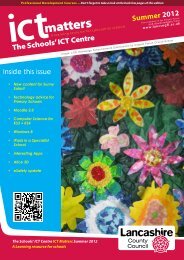Cover - Narrative Writing.pub
Cover - Narrative Writing.pub
Cover - Narrative Writing.pub
You also want an ePaper? Increase the reach of your titles
YUMPU automatically turns print PDFs into web optimized ePapers that Google loves.
The Teacher’s Role in Shared <strong>Writing</strong><br />
The session should be focused on just one or two teaching objectives from the text<br />
and sentence levels.<br />
If you use the techniques below during your Shared <strong>Writing</strong> sessions, you will<br />
gradually move your children towards greater independence:<br />
Teacher Demonstration<br />
• Most shared writing sessions begin with the teacher modelling how to write in<br />
a particular genre, always maintaining a clear focus on the objective(s).<br />
• The teacher thinks through the process aloud, rehearses everything orally<br />
before writing it down, makes changes and explains to the children why the<br />
changes were made and why one choice is preferable to another.<br />
• He/She writes the sentence, rereads it and amends again if necessary.<br />
• The teacher does not ask the children to contribute at this stage, but asks for<br />
their opinions on the choices made.<br />
Teacher Scribing<br />
• The children are asked to make contributions drawing on what they have<br />
learnt from the teacher’s demonstration.<br />
• The teacher limits the children’s contributions so they are only related to the<br />
objective(s) being taught.<br />
• He/She challenges the children’s contributions in order to refine their<br />
understanding, and their skills of composition.<br />
• The teacher asks the children to talk about their contributions with each other<br />
first before offering them to the rest of the class.<br />
• He/She asks more able children to note their ideas down on a whiteboard.<br />
These can be looked at either as good examples, or used as teaching points.<br />
Supported Composition<br />
• The children get to compose, and try out what they have been learning for<br />
themselves.<br />
• They use whiteboards and dry-wipe markers to write individually or in pairs.<br />
• They are asked to write a short amount of text that sharply focuses on the<br />
objective they are studying.<br />
• The children hold up their ideas for the teacher to see.<br />
• Good examples are celebrated, and misconceptions identified and corrected.<br />
• Supported composition could take place over the full 30 minutes of the shared<br />
session. This would allow some in depth work on the particular language<br />
feature.



